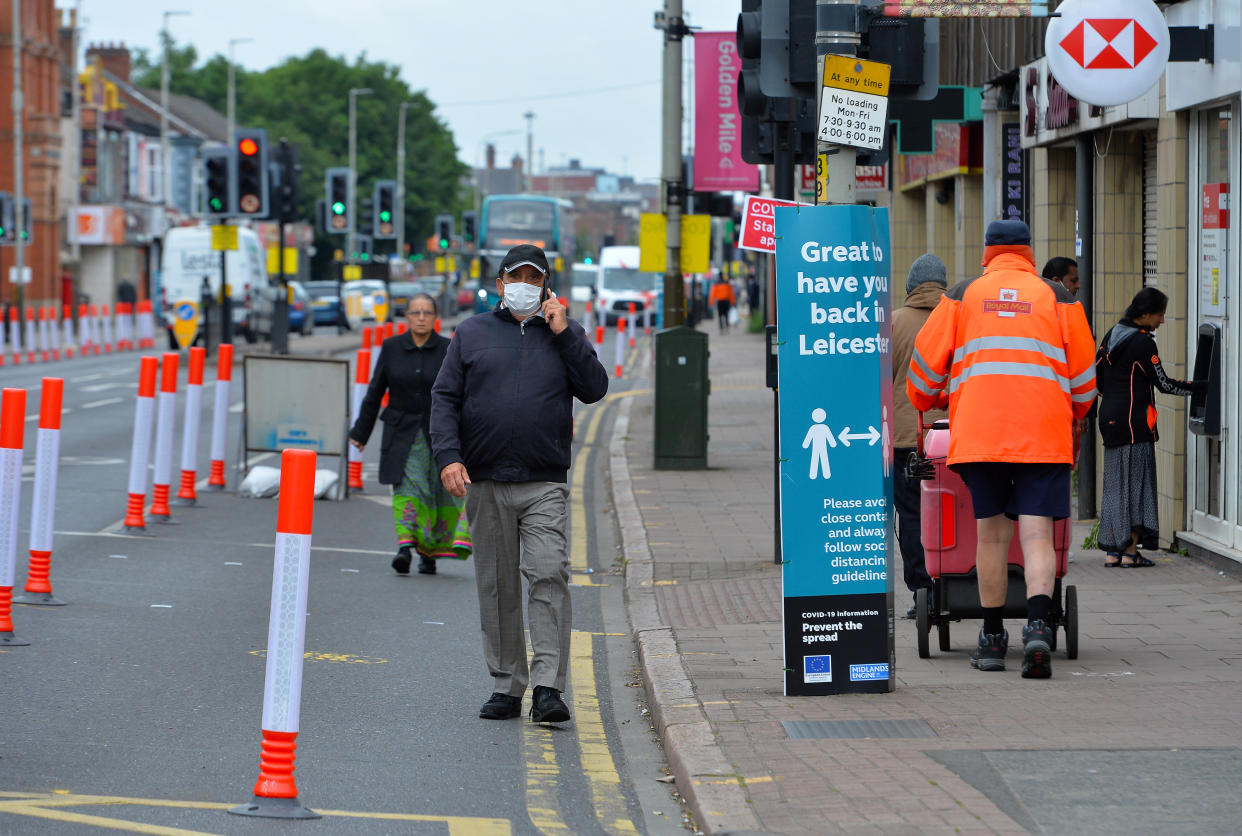Revealed: The areas with the highest number of coronavirus cases in England

The government has revealed the areas which had the most new coronavirus cases in England last week.
Leicester, which was placed under a “local lockdown” on Monday following a spike in cases, remained the council area with by far the most COVID-19 infections in the week ending 28 June.
According to the latest Public Health England (PHE) surveillance reports published on Thursday, the East Midlands city had 141.3 positive cases per 100,000 people, slightly up from 140.2 in the week ending 21 June.
However, there was better news for Bradford, which remained second in the country. Its latest infection rate was 45.8 per 100,000 people, but this was well down from 69.4 in the previous week.
Barnsley and Rochdale, which had also experienced a relatively high number of COVID-19 cases, also saw a reduction of infections in the week ending 28 June.
Here are the 10 council areas in England with the highest COVID-19 infections per 100,000 people in the week ending 28 June. For the full list, go to the bottom of the page.
Leicester 141.3 (up from 140.2)
Bradford 45.8 (down from 69.4)
Barnsley 35.1 (down from 54.7)
Rochdale 35.0 (down from 53.6)
Oldham 30.1 (down from 38.6)
Kirklees 26.2 (down from 30.3)
Rotherham 26.1 (down from 33.6)
Sheffield 24.4 (up from 20.6)
Bolton 23.5 (up from 15.8)
Doncaster 21.3 (up from 17.4)
Though Thursday’s figures will help allay fears of further local lockdowns being imposed, the government remains under pressure to start making accurate daily figures publicly available.
Currently, only pillar 1 data is publicly available every day through the government’s coronavirus data service. It is based on positive tests of NHS and care workers, as well as patients in hospitals. However, this only accounts for a minority of the actual number of cases.
It is pillar 2 data, based on testing in the wider community, which accounts for the majority: more than 75% of cases. This information is not available daily. It is currently only made public every Thursday as part of PHE’s weekly surveillance reports.
Amid the fallout of the Leicester lockdown, academics, medical experts and opposition MPs have this week argued for daily pillar 2 data to be made available.
Dr Duncan Robertson, lecturer in management sciences at Loughborough University, told Yahoo News UK that access to the latest local information will create “confidence in the measures that are being placed on people”.
He added: “If people don’t have confidence in the data, there’s likely to be less compliance with the measures that are taking place.”
Here is the full list, by council areas in England, of COVID-19 infections per 100,000 people in the week ending 28 June:
Leicester 141.3
Bradford 45.8
Barnsley 35.1
Rochdale 35.0
Oldham 30.1
Kirklees 26.2
Rotherham 26.1
Sheffield 24.4
Bolton 23.5
Doncaster 21.3
Blackburn with Darwen 20.8
Knowsley 20.1
Peterborough 18.9
Bedford 18.1
Manchester 17.5
Leicestershire 17.3
Tameside 16.9
Luton 15.0
Calderdale 14.8
Stoke-on-Trent 14.1
Blackpool 13.6
Derby 12.8
Hammersmith and Fulham 12.4
Leeds 11.7
Cheshire East 11.3
Kent 10.0
Northamptonshire 9.9
Cheshire West and Chester 9.7
Hounslow 9.2
Wakefield 9.0
Slough 8.7
Nottingham 8.5
Wirral 8.4
Southend-on-Sea 8.2
Staffordshire 7.9
Salford 7.9
Liverpool 7.7
Wolverhampton 7.6
Lancashire 7.4
Shropshire 7.2
Thurrock 7.0
Swindon 6.8
Ealing 6.7
St. Helens 6.7
Derbyshire 6.5
Solihull 6.5
Stockport 6.5
Birmingham 6.5
Hartlepool 6.4
Kensington and Chelsea 6.4
Middlesbrough 6.4
Bury 6.3
Halton 6.2
Hillingdon 5.9
Merton 5.8
Warrington 5.7
Barking and Dagenham 5.7
Central Bedfordshire 5.6
Warwickshire 5.6
Stockton-on-Tees 5.6
Sandwell 5.5
Brent 5.4
Havering 5.4
Nottinghamshire 5.4
Redcar and Cleveland 5.1
Telford and Wrekin 5.1
North Yorkshire 5.0
Sefton 4.7
East Riding of Yorkshire 4.7
Waltham Forest 4.7
Westminster 4.7
Medway 4.7
Wigan 4.6
County Durham 4.6
East Sussex 4.5
Oxfordshire 4.4
Milton Keynes 4.1
Wandsworth 4.0
Kingston upon Hull, City of 3.8
Trafford 3.8
North Somerset 3.7
Cambridgeshire 3.7
Newcastle upon Tyne 3.7
Cumbria 3.6
Enfield 3.6
Worcestershire 3.6
Buckinghamshire 3.5
Essex 3.5
North Lincolnshire 3.5
Bexley 3.2
Walsall 3.2
Reading 3.1
Richmond upon Thames 3.1
Lincolnshire 3.0
Wokingham 3.0
Haringey 3.0
Surrey 2.9
North Tyneside 2.9
West Sussex 2.9
Croydon 2.9
Harrow 2.8
Greenwich 2.5
Brighton and Hove 2.4
Hertfordshire 2.4
Redbridge 2.3
Plymouth 2.3
Northumberland 2.2
Dudley 2.2
Isle of Wight 2.1
Bristol, City of 1.9
York 1.9
North East Lincolnshire 1.9
Sunderland 1.8
Kingston upon Thames 1.7
Newham 1.7
Lewisham 1.7
Bracknell Forest 1.6
Southwark 1.6
Herefordshire, County of 1.6
Norfolk 1.6
Barnet 1.5
Sutton 1.5
Hackney 1.4
Cornwall and Isles of Scilly 1.4
Wiltshire 1.4
Coventry 1.4
West Berkshire 1.3
Dorset 1.1
Bournemouth, Christchurch and Poole 1.0
Gloucestershire 1.0
Darlington 0.9
Tower Hamlets 0.9
Suffolk 0.9
Somerset 0.9
Islington 0.8
South Gloucestershire 0.7
South Tyneside 0.7
Windsor and Maidenhead 0.7
Bromley 0.6
Gateshead 0.5
Hampshire 0.4
Southampton 0.4
Camden 0.4
Devon 0.4
Lambeth 0.3
Bath and North East Somerset 0
City of London 0
Portsmouth 0
Rutland 0
Torbay 0
Coronavirus: what happened today
Click here to sign up to the latest news, advice and information with our daily Catch-up newsletter
Read more about COVID-19
How to get a coronavirus test if you have symptoms
How easing of lockdown rules affects you
In pictures: How UK school classrooms could look in new normal
How public transport could look after lockdown
How our public spaces will change in the future
Help and advice
Read the full list of official FAQs here
10 tips from the NHS to help deal with anxiety
What to do if you think you have symptoms
How to get help if you've been furloughed

 Yahoo News
Yahoo News 

